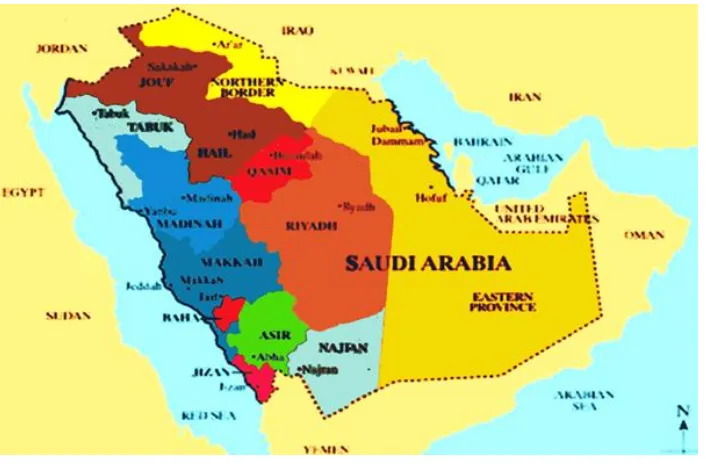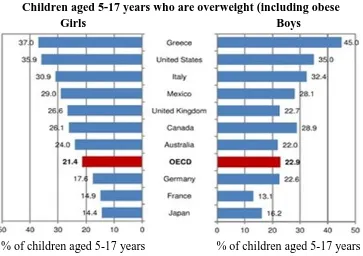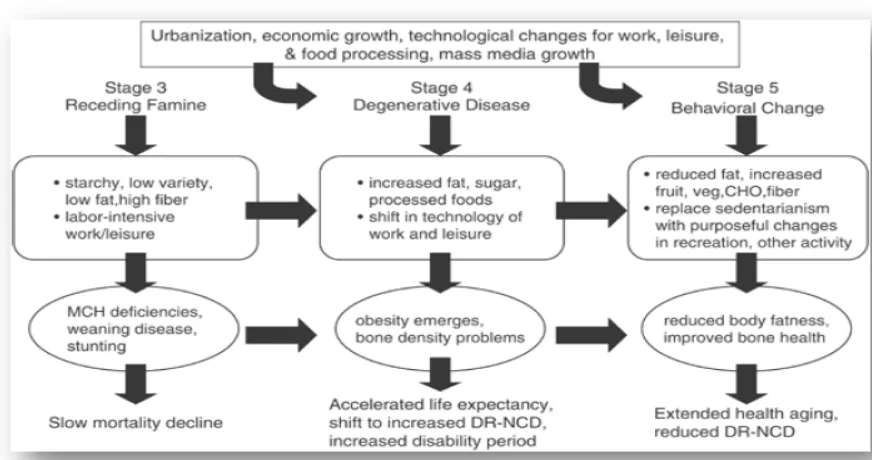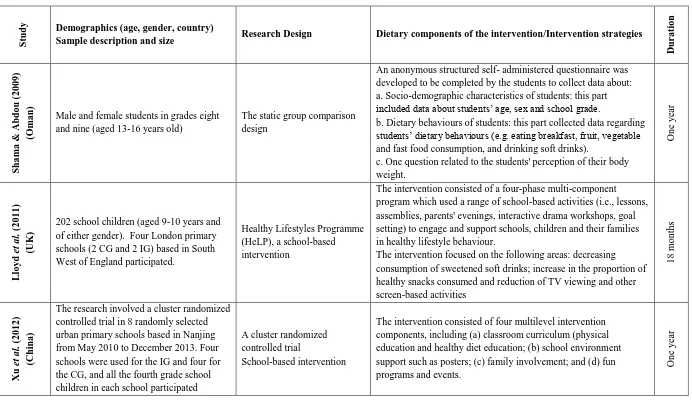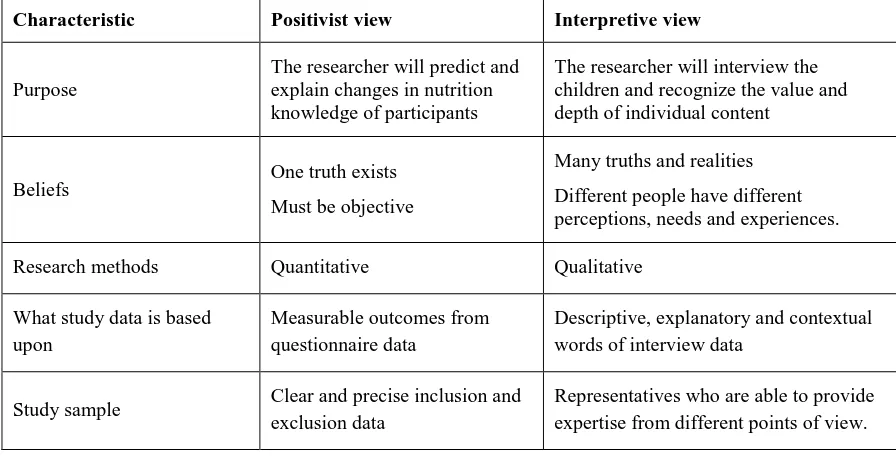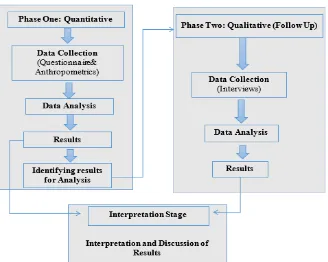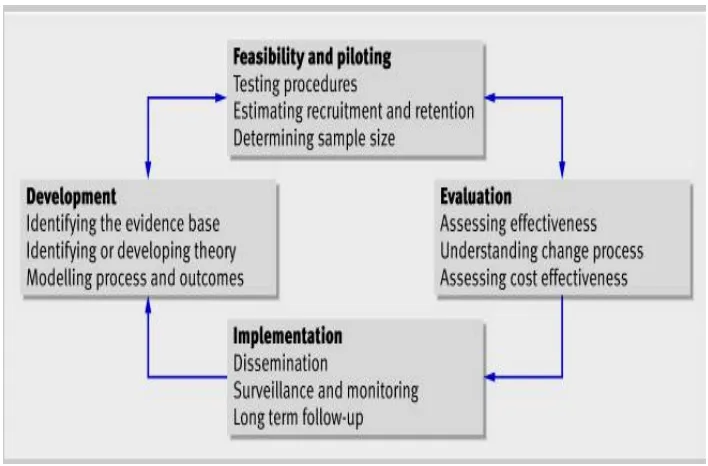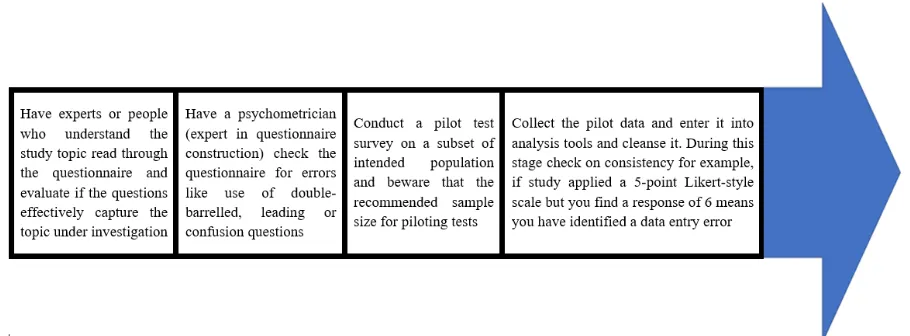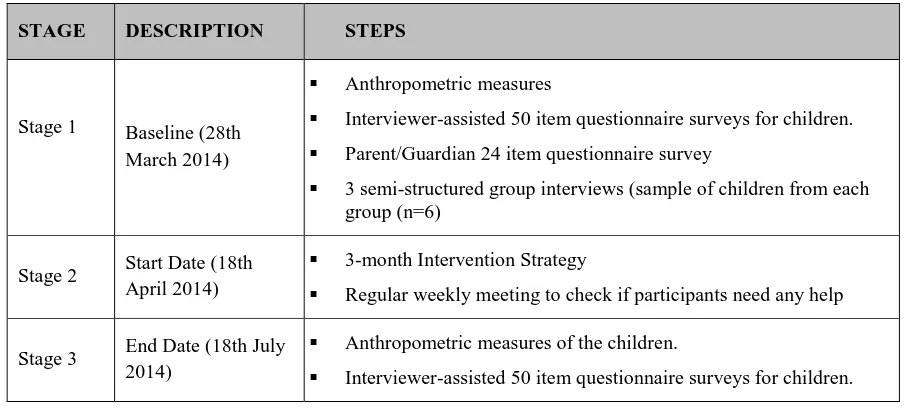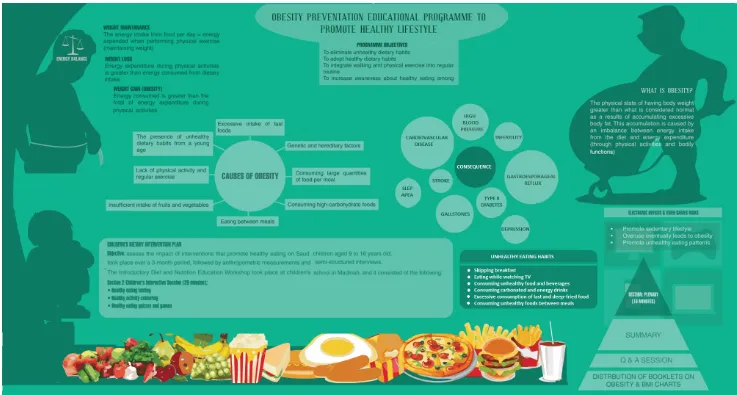i
Assessing the Effectiveness of an Obesity-Prevention
Intervention to Improve Healthy Lifestyle among Saudi
School Girls Aged 9 to 16: A Feasibility Study
Duaa Hasan Hefni
Submitted in Partial Fulfilment of the Requirements of the
Degree of Doctor of Philosophy
University of Salford, Manchester, United Kingdom
School of Health and Society
ii
Table of Contents
List of Tables ... viii
List of Figures ... ix
Abbreviations ... xi
Acknowledgements ... xii
Dedication ... xii
Abstract ... xiii
Chapter One: Introduction ... 1
1.1. Introduction ... 1
1.2. Overview ... 1
1.3. Overview of the Kingdom of Saudi Arabia ... 3
1.4. Statement of the Problem ... 4
1.5. Significance of the Study ... 5
1.6. Motivation for the Study ... 7
1.7. Research Aim and Objectives... 8
1.8. Research Questions ... 8
1.9. Structure of this Thesis ... 9
1.10. Summary ... 10
Chapter Two: Literature Review ... 11
2.1. Introduction ... 11
2.2. Search Strategy ... 11
2.2.1. Searched Databases ... 12
2.2.2. Extra Sources ... 12
2.2.3. Search Terms ... 13
2.2.4 Inclusion and Exclusion Criteria ... 13
2.2.5. Search Results ... 14
2.2.6 Quality of Studies ... 14
2.3. Causes of Childhood Obesity ... 15
2.4. Health Implications of Childhood Obesity ... 16
2.5. Global Childhood Obesity Prevalence ... 16
2.6. Childhood Obesity Prevalence in Saudi Arabia ... 18
2.7. Tackling the Childhood Obesity Problem in Saudi Arabia ... 21
2.8. Nutritional Transition and Childhood Obesity ... 22
2.9. Diet, Physical Activity and Childhood Obesity ... 24
2.9.1. Diet ... 24
2.9.2. Physical Activity ... 26
2.9.3. Relationship of Diet, Physical Activity and Childhood Obesity ... 28
2.9.4. Emotions, Social Setting, and Eating Behaviour and Childhood Obesity ... 29
2.10. Childhood Obesity Prevention Interventions ... 31
iii
2.11.1. Culture ... 34
2.11.1.1 Dietary traditions ... 34
2.11.1.2 Ramadan and Eid ... 35
2.11.1.3 Religiously motivated claims and bans ... 35
2.11.1.4 Inequality of curriculum between boys’ and girls’ education ... 35
2.11.1.5 Housemaids ... 36
2.11.1.6 Lack of supervision ... 36
2.11.2. The School Setting ... 36
2.11.3. Parent’s and Teacher’s Role ... 38
2.11.4. Duration of Intervention ... 39
2.11.5. Behaviour Change ... 41
2.11.6 Appraisal and Quality Assessment of Included Studies ... 44
2.11.6.1 Study Aims ... 45
2.11.6.2 Study Design ... 45
2.11.6.3 Impact of Interventions on Dietary Habits ... 47
2.11.6.4 Impact of Intervention on Physical activity and Sedentary Behaviour... 50
2.11.6.5 Reviewed Studies Summary of Key Findings ... 51
2.11.6.6 Strengths and Limitations of Studies ... 55
2.12 Theories Used in School-based Obesity Interventions ... 56
2.12.1 Selecting a Health-Behaviour Theory ... 56
2.12.2 Major Health Behaviour Theories ... 57
2.12.2.1 The Health Believe Model ... 57
2.12.2.2 (Stages of) Behaviour Change Theory ... 57
2.12.2.3 Theory of Reasoned Action ... 58
2.12.2.4 Social Cognitive Theory (SCT) ... 58
2.12.2.5 Health Behaviour Theory ... 58
2.12.3.The Social Cognitive Theory... 59
2.12.4 Constructs of Social Cognitive Theory ... 61
2.12.4.1 Personal Factors ... 61
2.12.4.2 Behavioural Factors ... 61
2.12.4.3 Environmental Factors... 61
2.13. Gaps in Theory, Knowledge and Practice ... 62
2.14. Summary ... 62
Chapter Three: Methodology ... 64
3.1. Introduction ... 64
3.2 Research Paradigms and Philosophy ... 64
3.3. Paradigms and Methodology ... 66
iv
3.3.2 Qualitative Methodology ... 67
3.3.3 The Mixed Methods Approach ... 68
3.4. Research Design ... 70
3.4.1. Implementation Sequence ... 71
3.5 Medical Research Council (MRC) Framework ... 72
3.5.1 Developing complex interventions ... 72
3.5.2 Assessing Feasibility ... 73
3.5.3 Evaluation ... 74
3.5.4 Implementation ... 74
3.6 Study Site ... 74
3.7 Pilot Study ... 74
3.8 Study Sample ... 76
3.9 Data Collection ... 77
3.9.1 Quantitative Data Collection ... 77
3.9.1.1 Questionnaire Development ... 78
3.9.1.2 Validity and Reliability of Developed Questionnaire ... 78
3.9.1.3 Children’s Self-Reported Questionnaires ... 80
3.9.1.4 Parent’s Self-Report Questionnaires ... 80
3.9.1.5 Anthropometric Measurements ... 81
3.10 Qualitative Data Collection ... 81
3.10.1 Interviews ... 81
3.11 Ethical Considerations and Data Protection ... 82
3.12 Cultural Considerations ... 83
3.13 Organisation of Data Collection ... 83
3.14 Development of the Intervention Programme ... 87
3.14.1 Precede Model for Education-Based Intervention ... 87
3.14.2 Children’s Dietary Intervention Plan... 88
3.14.3 Programme Objectives ... 89
3.14.4 Major Content ... 91
3.15 Data Analysis ... 94
3.15.1 Quantitative Analysis ... 94
3.15.2 Qualitative Data Analysis ... 95
3.15.3 Thematic Analysis ... 95
3.15.4 Framework Method ... 96
3.16 Rigour in Qualitative & Quantitative Research ... 97
3.16.1 Validity ... 99
3.16.2 Criteria of Trustworthiness ... 99
3.16.2.1 Credibility ... 99
3.16.2.2 Transferability ... 100
v
3.16.2.4 Conformability ... 102
3.17 Summary ... 103
Chapter Four: Results ... 104
4.1. Introduction ... 104
4.2. Quantitative Data Results ... 104
4.3. Pre-Intervention ... 104
4.3.1. Children’s Questionnaires ... 104
4.3.1.1. Section A: Personal Details ... 104
4.3.1.2. BMA as a function of Age ... 107
4.3.1.3. Section B: Activities and Lifestyle ... 107
4.3.1.4. Section C: Diet and Nutrition ... 110
Participant Food Intake ... 110
Association between Quantity of Food intake and BMI ... 112
Fast Food Intake ... 113
Snacks Consumption Pattern ... 113
4.3.2 Parent’s Questionnaire... 114
4.3.2.1 Section A: Parent’s Education and Employment Status ... 114
4.3.2.2. Section B: Parent’s Health ... 115
4.3.2.3 Section C: Parent’s Perceived Child’s BMI and Sedentary Activity ... 116
4.3.2.4. Section D: Child’s Diet and Nutrition ... 118
4.4. Post Intervention Results ... 120
4.4.1 Section A: Weight and BMI ... 121
4.4.2. Section B: Activities and Lifestyle ... 121
4.4.2.1. Sedentary Activity ... 121
4.4.2.2.BMI as a Function of Hours Spent Across Activities ... 121
4.5 Participant Involvement in Physical Activity ... 122
4.6. Section C: Diet and Nutrition ... 124
4.6.1. Food Intake ... 124
4.6.2. Breakfast Intake ... 127
4.6.3. Snacks Consumption ... 128
4.7. Comparison between pre- and post- intervention ... 128
4.7.1. Section A: Weight and BMI ... 128
4.7.2. Section B. Activities and Nutrition ... 129
4.7.2.1. Sedentary Activity ... 129
4.7.2.2. Physical activity ... 130
4.7.2.3. Nutrition Intake ... 131
4.8. Impact of the Intervention on Overweight and Obese Children ... 133
vi
4.8.2. Sedentary Activity ... 136
4.8.3. Physical Activity ... 136
4.8.4. Nutrition ... 137
4.9. Quantitative Results Summary ... 139
4.10. Qualitative Data Results ... 140
4.10.1 Introduction of Themes ... 140
4.10.2. Developed Study Themes ... 140
4.10.2.1. Theme 1: Psychological Factors that Impact on Obesity ... 140
4.10.2.1.1. Perception of Healthy Food Choices ... 141
4.10.2.1.2. Perceptions of Unhealthy Food ... 144
4.10.2.1.3. Mood and Food Consumption ... 145
4.10.2.1.4. Self-perception and Food Consumption ... 147
4.10.2.2. Theme 2: Environmental Factors, Place and Culture- Influence on Diet ... 148
4.10.2.2.1. Access to Physical Activities... 149
4.10.2.2.2. Physical Activities and School Environmental Factors ... 150
4.10.2.2.3. Physical Activities Outside School ... 151
4.10.2.3 Theme 3: Influence of Knowledge Attitude and Belief in Existing Obesity Prevention Strategies ... 153
4.10.2.3.1. Perceptions of Diets to Reduce Weight ... 156
4.11. Reflexivity ... 158
4.12. Qualitative Summary ... 159
4.13.Qualitative Data Summary ... 160
Chapter Five: Findings and Discussion ... 161
5.1. Introduction ... 161
5.2. Current Real Problem ... 161
5.3. Quantitative and Qualitative Findings ... 162
5.4. Key Findings ... 163
5.4.1. Impact of Nutritional Education ... 164
5.4.1.1. Diet and Nutrition ... 164
5.4.1.2. Physical Activity ... 166
5.4.1.3. Sedentary Activity(SD) ... 168
5.4.1.4. Combining Diet and Nutrition, Physical Activity and Sedentary Activity ... 170
5.4.2. Knowledge or Awareness of Diet and Nutrition ... 171
5.4.3. Knowledge or Awareness of Physical Activity ... 172
5.5. Effectiveness of the Intervention ... 173
5.6. Theoretical Framework... 174
5.7. Strengths of the Study ... 176
5.8. Limitations of the Study ... 177
5.9. Summary ... 178
vii
6.1. Introduction ... 180
6.2. Contribution to Existing Knowledge ... 180
6.3. Recommendations ... 182
6.3.1. Recommendations for Policy ... 182
6.3.2. Recommendations for Practice ... 183
6.3.3. Recommendations for Further Research ... 184
6.4. Dissemination Plan ... 185
6.5. Summary ... 185
References ... 186
Appendixes ... 213
Appendix 1: Self-Reported Questionnaire (Children) ... 213
Appendix 2: Self-Reported Questionnaire (Parents) ... 214
Appendix 3: Anthropometric measures ... 224
Appendix 4: Information sheet (parents). ... 226
Appendix 5: Research withdrawal form ... 228
Appendix 6: Ethics approval ... 229
Appendix 7: Semi-Structured Interview Questions (Children) ... 232
Appendix 8: An interview consent form ... 234
Appendix 9: An example of participant short form semi structured interview transcript . 236 Appendix 10: An Obesity Information Booklet ... 242
Appendix 11: Designed Dietary Plan ... 244
Appendix 12: Pearson Product-Moment ... 246
Appendix 13: Analysis of Variance (ANOVA) ... 247
Appendix 14: Consent Form (Parents) ... 248
Appendix 15: Dietary intervention plan for children. ... 249
Appendix 16: An example of picture ... 251
Appendix 17: Children's Interactive Session ... 252
Appendix 18: Children's dietary intervention poster: ... 253
Appendix 19: Calorie counter... 254
Appendix 20: BMI chart ... 256
Appendix 21: Summary of Themes and Categories Developed Based on the Interview Data Gathered ... 257
viii
List of Tables
Table 1. Categorisation of health consequences of childhood obesity adopted from Mayo Clinic (2014) and Food
Research and Action Centre (FRAC) (2015) ... 17
Table 2. Summary of Intervention Studies. ... 53
Table 3. Summary of Research Paradigms and their relationship with methodology adopted from Locke et al (2000). ... 65
Table 4. Research Time Plan ... 84
Table 5. Substitution in favour of healthy foods. ... 93
Table 6. An overview of the results structure in Chapter Four. ... 105
Table 7. Frequency distribution for age. ... 105
Table 8. Frequency and relative frequency distribution of Age groups ... 106
Table 9. Frequency of children living with either parents or alone parent ... 106
Table 10. Descriptive statistics for height, weight and BMI for children ... 106
Table 11. Frequency distribution for BMI categories ... 107
Table 12. Descriptive statistics for BMI for different age groups ... 107
Table 13. Frequency distribution for daily hours children are involved in sedentary activities ... 108
Table 14. Mean (M) and standard deviation (SD) for BMI for each category of each activity ... 108
Table 15. Frequency and Fisher’s Exact Test for the association between BMI and quantity of food intake... 112
Table 16. Mean and standard deviation for the number of food intakes per week for each type of snack ... 113
Table 17. Mean and standard deviation for height, weight and BMI for fathers and mothers ... 116
Table 18.Frequency for each family history health problem ... 116
Table 19. Parent’s report of child’s weight status ... 117
Table 20. Frequency distribution of children’s sedentary activity and sleep, per day, from the view of their parents ... 118
Table 21. Frequency for each question about the children’s diet and nutrition questionnaire ... 120
Table 22. Descriptive statistics for height, weight and BMI after the intervention ... 121
Table 23. Frequency distribution for BMI categories ... 121
Table 24. Frequency distribution for the number of daily hours children are involved in daily sedentary activities ... 122
Table 25. Mean and standard deviation for BMI for each category of each activity ... 122
Table 26. Frequency and Fisher’s Exact Test for the association between BMI and quantity of food intake... 126
Table 27. Mean and standard deviation for the number of food intakes per week for each type of food ... 128
Table 28. The five children who lost weight after intervention ... 135
ix
List of Figures
Figure 1. KSA map with regional divisions shown, (Image adopted from globalsecurity.org). ... 3
Figure 2. Obesity rates in different countries for 5-17-year-old children (Source OECD.org; Scollan-Koliopoulos 2011). ... 18
Figure 3. Nutrition transition diagram. ... 24
Figure 4. Illustrates how the current research implemented the research design. ... 71
Figure 5. The MRC framework adopted in this study (MRC, 2007). ... 73
Figure 6. Colling ridge questionnaire validation procedure and process adopted from Krishna Swamy and colleagues (2012). ... 79
Figure 7. Obesity prevention educational programme. ... 90
Figure 8. Thematic Analysis Diagram adopted from NatCen Learning (2012). ... 96
Figure 9. Mean of participation in each sport/activity ... 109
Figure 10. Mean BMI for each category of hours of exercise per week. ... 109
Figure 11. Mean number of weekly hours spent exercising for each BMI category ... 110
Figure 12. Frequency of the number of times a week or day of dietary intake of fast food, non-diet and diet soft drinks, energy drinks, snacks, meat, beans or nuts, bread or cereals (week) and vegetables, fruit and dairy products (day) ... 111
Figure 13. Frequency of participants for each type of fast food ... 113
Figure 14. Frequency of participants who eat each type of food for breakfast ... 114
Figure 15. Frequency of education level for father and mother ... 115
Figure 16. Employment for fathers and mothers ... 115
Figure 17. Bar chart contrasting the proportion of children in each BMI category and the proportion of parents who reported their children in each BMI category ... 117
Figure 18. Bar chart showing children’s and the parents’ answers regarding the amount of time children spend in each activity. ... 118
Figure 19. Frequency of parents who reported having arguments about their children’s eating habits ... 119
Figure 20. Frequency of participants involved in each Sport/Activity ... 123
Figure 21. Mean BMI for each category of hours of exercise per week ... 123
Figure 22. Mean number of hours a week spent exercising for each BMI category. ... 124
Figure 23. Frequency of the number of times a week or day of dietary intake of fast food, non-diet and diet soft drinks, energy drinks, snacks, meat, beans or cereals (week) and vegetables, fruit and dairy products (day) ... 125
Figure 24. Frequency of participants for each type of fast food ... 127
Figure 25. Frequency of participants who eat each type of food for breakfast ... 127
Figure 26. Frequency for BMI categories before and after the intervention ... 129
Figure 27. Frequency of the number of hours watching TV before and after the intervention. ... 130
Figure 28. Frequency of the number of hours spent on the computer before and after the intervention. ... 130
Figure 29. Frequency of the number of hours spent using smartphones or tablets before and after the intervention ... 130
Figure 30. Frequency of the number of hours spent playing video games before and after the intervention. ... 130
Figure 31. Frequency of fast food intake before and before and after the intervention. ... 130
Figure 32. Frequency of non-diet drinks before and after the intervention. ... 130
Figure 33. Frequency of the mean of different physical activities ... 131
x
Figure 35. Frequency of non-diet drinks before and after the intervention. ... 132
Figure 36. Frequency of diet drinks intake before and after the intervention. ... 132
Figure 37. Frequency of snacks intake before and after the intervention ... 132
Figure 38. Frequency of meat intake before and after the intervention... 132
Figure 39. Frequency of beans or nuts intake before and after the intervention. ... 132
Figure 40. Frequency of bread or cereals intake before and after the intervention. ... 133
Figure 41. Frequency of vegetables intake before and after the intervention. ... 133
Figure 42. Frequency of fruit intake before and after the intervention. ... 133
Figure 43. Frequency of dairy products intake before and after the intervention. ... 133
Figure 44. BMI categories before and after the intervention ... 134
Figure 45. BMI before and after the intervention ... 135
Figure 46. Frequency of hours spent on watching TV. ... 136
Figure 47. Frequency of hours spent using a Compute. ... 136
Figure 48. Frequency of time spent on Tablets/smartphones. ... 136
Figure 49. Frequency of times of non- diet drink intake weekly. ... 137
Figure 50. Frequency of times of fast food intake weekly. ... 137
Figure 51. Frequency of times of energy drinks intake. ... 137
Figure 52. Frequency of times of diet drinks intake. ... 137
Figure 53. Frequency of times eating bread or cereals. ... 138
Figure 54. Frequency of times of eating beans and nuts. ... 138
Figure 55. Frequency of times eating fruit. ... 138
Figure 56. Frequency of times eating of eating vegetables. ... 138
xi
Abbreviations
ANOVA Analysis of variance
BMI Body Mass Index
CDC Centre for Disease Control and Prevention
CG Control Group
CVI Content validity index
DNK Diet and Nutrition Knowledge FRF Frequency and Relative Frequency HIV Human Immunodeficiency Virus
HSCIC The Health and Social Care Information Centre IG Intervention Groups
IOTF The International Obesity Task Force
kCal Kilo Calorie
Kg Kilogram
KSA Kingdom of Saudi Arabia
m2 Square Metre
MET Metabolic Equivalent NHS National Health Service OHR Overall Health Rating
PA Physical Activity
PCA Principal Component Analyses
R-CVI The representative content validity index RPs Research Participants
SAL Sedentary and Activity Level SPA Sedentary and Physical Activities
UK United Kingdom
STI Sexually Transmitted Infections
US United States
xii
Acknowledgements
My utmost thanks to Allah for blessing me with the opportunity, ability and inspiration to conduct this study. I express my heartfelt appreciation to my supervisors: Prof Tony Warne, Dr Joy Probyn and Prof Caroline Hollins Martin, for their relentless support, guidance and patience. It was a very inspiring stint to be under your leadership.
I give special thanks to my family members and friends for their encouragement, support and inspiration to achieve my studies this far.
Further, I acknowledge and thank the Ministry of Health, Kingdom of Saudi Arabia that granted me the chance to complete my studies in the United Kingdom. I extend my gratitude to all participants in this study including schoolgirls, their parents or sponsors, school nurse and teachers. I thank the school head teacher for her permission and support to complete this study. This study would not have been complete without your participation, thanks again.
Dedication
This thesis is dedicated to my lovely sons Hassan and Hamza. Your love and existence in my life is a motivation to achieve more in life.
I further dedicate this study to my family: my late Father who would inevitably be proud of his daughter - all mercy on his soul, I would like to thank my brothers Zaid, Amro, Fahad and Ashraf and my mother who offered unlimited support and encouragement along this study journey. My family instilled in me courage and hopes to overcome life’s challenges and achieve my Doctoral studies, thank you for believing in me.
xiii
Abstract
The prevalence of overweight and obesity is increasing worldwide at an alarming rate and the Kingdom of Saudi Arabia at increased risk of a multitude of obesity-associated problems. There are multiple causal factors associated with childhood obesity, but the modifiable ones are dietary and activity behaviours. In order to accomplish this, it is vital to assess and evaluate whether an intervention to promote healthy lifestyle behaviours in school-age girls is effective in reducing their Body Mass Index (BMI). To measure the effect of such an intervention requires a large sample across a wide geographical mass and therefore a feasibility study is necessary before conducting a study of this size, to explore the most effective form of the intervention and methods for measuring its effectiveness. Although several obesity-related intervention studies were published worldwide, the current feasibility study was conducted for the first time in Madinah, Saudi Arabia. Therefore, this feasibility study was conducted to determine the viability of promoting healthy eating and physical activity with school girls (aged 9 to 16 years) in Saudi Arabia, in order to prevent childhood obesity.
Saudi schoolgirls were included in the current feasibility study, using both quantitative and qualitative methods. A sequential explanatory design was adopted, allowing sequential implementation of quantitative and qualitative components. Parent questionnaires (n=90) on children’s nutrition and physical activity habits were issued pre-intervention. A children’s self-report questionnaire (n=90) and anthropometric measures were conducted pre- and post-intervention to assess the impact of the education programme. Semi-structured interviews (n=18) were conducted to explain the results from the questionnaires. The intervention aims to promote healthy eating and physical activity in Saudi School children, based on the constructs of the Social Cognitive Theory. The intervention consisted of two components: a presentation and interactive sessions delivered in about 2 hour session at Taibah school.
xiv
reduced. Reported decrease in consumption of unhealthy foods while healthy foods increased. There were no significant differences between pre- and post-intervention weight (p=0.669) or BMI (p=0.856). BMI categories changed, indicating more normal weight and fewer overweight participants. Further, the qualitative data analysis indicated that participants had prominent level of sedentary activities, mainly playing video or watching television. These data, also, indicated culture impact on the choice of food and level of physical activity.
The school-based intervention was found to be a feasible intervention that motivates changes in lifestyle behaviours and BMI. Regular physical education and healthy eating classes, and increased access to healthy foods at school shops can help to combat obesity. This school based-intervention has shown potential to improve health lifestyle among Saudi girls and to prevent childhood obesity, which can make a positive impact on their health. However, further research is needed to confirm the impact of obesity education intervention programme with a larger sample over a longer time-period.
Key Words:
1
Chapter One: Introduction
1.1. Introduction
Educational intervention programmes are essential to prevent obesity among school children in Saudi Arabia, to improve behaviour toward healthy food and physical activities. Generally, in the last two decades, obesity and gain weight among Saudi children has increased (Al Dhaifallah et al., 2015). The development and testing of such an educational programme requires a large-scale randomised controlled trial. This research study aimed to test the feasibility of a school-based intervention to reduce weight and obesity in school girls in a school in Madinah City. No previous research has been conducted with this population of Saudi children, with a view to conducting a large-scale RCT based on the results of the study. The literature has reported between twelve and eighteen months duration to conduct of obesity-related intervention research in different countries (Shama & Abdou, 2009; Lloyd et al. 2011; Habib-Mourad, 2013). However, conducting the current education intervention programme was about three months, due to time and resources constraints. The outcomes of this feasibility study will give a clear indication of the effectiveness of the educational intervention programme and the methods applied to evaluate its effectiveness. Therefore, this introductory chapter focuses on the concept of obesity and gives information related to Saudi Arabia.
1.2. Overview
2
considered 'obese'; and if over 40 a person is considered 'morbidly obese' (Flegal et al., 2010). Globally, the number of overweight and/or obese children under the age of five, in 2010, was estimated to be about 43 million and of this figure, 35 million were from developing countries (De-Onis et al., 2010). Worldwide prevalence of childhood overweight and obesity also increased from 4.2% in 1990 to 6.7% in 2010 and it may increase further by 2020 (De Onis et al., 2010).
It is clear that obesity may result in health risks or consequences if not controlled at an early stage. The literature recognises the link between physical activity, diet and obesity, asserting the increased potential to develop a range of serious diseases, as a result of being overweight or obese (Health and Social Care Information Centre, 2014). This is worsened in the case of childhood obesity as, children who are diagnosed as obese risk a greater likelihood of developing illnesses, experience repeated absence from school, struggle with health-related limitations and require constant medical attention than their normal weight counterparts (Health and Social Care Information Centre, 2014). Additionally, obese and overweight children are more likely to have adult obesity and develop obesity related conditions such as morbidity, disability and adult premature mortality.
3
address in public health research. This feasibility study discusses childhood obesity in the author’s country of origin, Saudi Arabia.
1.3. Overview of the Kingdom of Saudi Arabia
Saudi Arabia (Figure 1), officially known as the Kingdom of Saudi Arabia (KSA), is approximately 2,150,000 km square and considered the largest state of the Arabian Peninsula (World Factbook, 2013). KSA was established in the 18th century and its modern laws are Sharia-based given that the country is the birthplace and home to Islam’s two holy cities, Mecca and Al-Medina (Figure 1). The country’s administration is divided into thirteen provinces, which are further subdivided into governorates. KSA has a terrain of fairly barren and harsh gravel plains, salt flats and sand deserts. Nevertheless, KSA has emerged as an underdeveloped desert country to one of the wealthiest and developed nations in the region because of its oil resources (World Factbook, 2013).
Figure 1. KSA map with regional divisions shown, (Image adopted from globalsecurity.org)
[image:17.595.124.477.337.569.2]4
and civilisations and it influences both social and legal behaviour and practice (Saudi Embassy, 2013). The daily life of Saudi Arabian people is dominated by Islamic observance (World Factbook, 2013).
1.4. Statement of the Problem
Study reports indicate that KSA childhood obesity prevalence is increasing. The Centres for Disease Control and Prevention in 2000 reported that obesity affected about 17,825 (20.4%) of children aged between 5-18 years in KSA. In 2004, a KSA national survey conducted in rural areas argued that diabetes (associated with obesity) prevalence in children is increasing and that this might put additional pressure on the KSA health sector (Amin et al, 2008). In 2007, the World Health Organisation (WHO) reported that more than 19,317 (23.9%) KSA children between the age of 5 and 18 years were obese or overweight (El Mouzan et al., 2010). Al Shehri and colleagues (2013) have also argued that based on the latest KSA national data, rates of overweight and obesity among school-age children have reached 23% and 9.3% respectively. The Saudi Gazette (2013) claimed that obesity rates among Saudi children are about 18%. Those recorded findings depict a worrying trend that calls for necessary actions to prevent a further increase of childhood obesity and its consequences in KSA. Because child obesity is a behaviour-driven disease, it is important to understand the link between obesity and the KSA sociocultural behaviour history.
5
Based on the study findings about childhood obesity in KSA indicated above, it is possible to envisage challenges posed by childhood obesity that go beyond health risks. There are economic implications including increased healthcare costs derived from an overly obese KSA population in the long term, subsequent poor quality of life of citizens and children, as well as poor school attendance and performance owing to health problems associated with obesity. Obesity is therefore a major concern for KSA public health…that requires a reliable and long-term solution. As Al-Hazzaa and colleagues (2012) concluded; “primary prevention of obesity by promoting a healthy diet and active lifestyles should be a national public health priority”. This research study focused on exploring a reliable solution to preventing and controlling childhood obesity in KSA through an education-based intervention programme.
1.5. Significance of the Study
Childhood obesity has been cited as “one of the most serious public health challenges of 21st century” (WHO, 2011: 1). Examining childhood obesity and its prevention is significant as such a condition can harm nearly every system in a child’s body (heart, lungs, kidney, digestive tract, muscles, skeleton and hormonal control), and can have a detrimental effect on their social and emotional life, ultimately intensifying their risk of disease and disability later in life (Chan, 2013). The menace of obesity cannot be downplayed as it represents a major public health crisis nationally and internationally (James et al., 2008) given its long-term impact on the population health and the cost of health care (Karnik & Kanekar, 2012).
In KSA, the higher childhood obesity occurrence in Saudi females has turned into a serious public health risk. It is already the case that obesity’s associated risk factors such as coronary artery disease are high among females who have an obesity prevalence rate of 44% compared to their male counterparts who scored a prevalence rate of 26.4% (Al-Nozha et al., 2005). It is observed that childhood obesity often persists into adulthood, which makes it an important predictor of adult obesity (Bauman et al., 2009). Therefore, the importance of conducting research within this particular topic lies in the need for finding solutions to childhood obesity and its associated health risks.
6
effectiveness as a means of attaining significant positive behaviour change following nutritional knowledge imparted through obesity education. By giving consideration to the association of childhood obesity and lifestyle behaviour, the study is important as it attributes to education a decisive role marked by its capacity to inform and achieve a voluntary behaviour change in children. The study further assesses how obesity education results in optimum voluntary behaviour change. According to Sharma (2011), optimum behaviour change depends on how a planned education results in children’s perceived difference of healthy and unhealthy lifestyle practices. The study is influential for identifying the strengths and weaknesses of education based childhood obesity interventions, thus creating avenues for improving childhood obesity prevention and saving health costs.
Alhazaa (2012) recommends a number of factors for the prevention of childhood obesity which emphasise critical role lifestyle modifications, such as moderate physical activity, decreased TV viewing time and computer usage, reduced fast food intake and sugar-sweetened beverage. The study concludes that promoting active lifestyle and increase accessibility to healthy foods in Saudi Arabia should be a national public health priority. While the assertion made in this study by Alhazaa (2012), and found widely elsewhere in research by advocates the importance of making healthy diet options more readily available to counter obesity, this study contends that such measures can only be effective when coupled with efforts to address the problem with the inclusion of a multi-component approach and sociocultural considerations. As such, herein a unique contribution to this area is offered by implementing the recommendations for the prevention of childhood obesity in Saudi Schools. This research study will make a contribution to knowledge in the following ways:
It will fill a significant gap in the existing Saudi empirical literature on this topic, in
that it will incorporate the use of an intervention programme that differs from others given its multi-component approach, which combines the core factors of dietary habits, physical activity and sedentary activity. According to Sharma’s (2011) review of school-based intervention studies, the majority of previous school based intervention studies focused on two lifestyle factors while this study examines the influences of three factors (dietary habits, physical activity and sedentary activity). The study design and development are driven by considerations of Saudi sociocultural
7
It is assumed that this research study will contribute to knowledge through furthering understanding of the feasibility and effectiveness of this school-based intervention programme; in particular, when designed as a multi-component procedure henceforth taking into account the diverse factors pertinent to societal norms and culture. Realising the importance of such an approach to deepen understanding of the problem, this study adopted the following intervention factors: sedentary activities, dietary habits and Physical activity.
A thorough literature review of existing studies about childhood obesity among Saudi children found no previous attempts to implement a school-based intervention programme within Saudi girls’ schools in order to raise awareness of healthy dietary practices and lifestyle choices.
By addressing this, this study is expected to provide an insight for KSA’s public health practitioners, policy makers and nursing students in respect of childhood obesity prevention both at home and in the school setting.
1.6. Motivation for the Study
8 1.7. Research Aim and Objectives
This feasibility study sought to design and implement a school-based intervention programme as well as assess improving healthy lifestyle among school girls. This study was the first to be conducted in Madinah, Saudi Arabia. Thus, the aim of the intervention was to change behaviour to prevent obesity in the future. The emphasis of this prevention-oriented intervention programme was to apply culturally appropriate means to foster awareness and encourage the adoption of healthy lifestyle behaviours and choices. Therefore, the specific objectives were as follows:
1. To assess the current lifestyle behaviours of KSA schoolgirls aged 9-16 years at Taibah School in Madinah City in terms of dietary habits, physical activities, and sedentary activities.
2. To describe the contextual factors and the ways through which school girls are supported to or discouraged to conduct a healthy lifestyle, especially enhancing opportunities for healthy eating and noncurricular physical activity.
3. To determine the impact of the intervention in preventing or reducing obesity prevalence.
4. To identify potential components for designing and implementing an education intervention programme.
5. To pass certain recommendation based on the study findings to the authorities with the hope of translating the findings into practice.
6. To evaluate the intervention and the study methods with a view to conducting a large-scale RCT of the educational intervention with a large population after this study.
1.8. Research Questions
The following research questions were formulated to address the central themes of the study:
1. What type of physical and sedentary activities do KSA schoolgirls engage in at home and at school?
2. Does the environment provide adequate choices for healthy foods, physical activities and facilities?
9 1.9. Structure of this Thesis
There are six chapters in this thesis: Introduction, Literature Review, Methodology, Results, Findings and Discussion, and Conclusion and Recommendations.
Chapter 1 presents a comprehensive introduction of this current study and its context. The chapter starts by describing obesity and the geography of KSA. It also explains the importance of conducting this study, the purpose and key objectives and sets out the questions that this study seeks to address. Chapter 2 covers a review of the literature that was carefully selected using a search strategy and then subjected to detailed analysis to confirm the relevance of the studies. The literature focused on critical subjects of childhood obesity including causes of childhood obesity, health implication of childhood obesity, global childhood obesity prevalence and combating childhood obesity using nutrition and physical activity. Chapter 2 further focuses on The studies summarised in (Table2) and key areas include: the aims of the study, the study design, the impact of the intervention and the most important findings. Using these key areas as a measure of quality and rigorous practice, the studies will be critically appraised to understand the effectiveness of a school-based intervention in the prevention of childhood obesity, school-based education intervention studies and their beneficial effects, the theoretical framework they used, the methods they applied and their merits and limitations for informing the design and implementation of this study’s primary research.
10 1.10. Summary
11
Chapter Two: Literature Review
2.1. Introduction
In order to establish an effective childhood obesity intervention, as part of the feasibility study, the current Chapter focuses on the concept of the theoretical framework related the current project. It starts with an explanation of the search strategy employed in the research process. It then identifies and describes childhood obesity prevalence, contributing factors such as nutritional transition, and health and psychological impacts in relation to Saudi Arabia. The chapter ends by critically reviewing school-based interventions and their role in preventing childhood obesity. Appraisal and quality assessment of included studies .Blanchette et al, (2005) defined literature review as a process of identifying and analysing existing literature and information that is related to the topic of study. Theories Used in School-based Obesity Interventions. Boote and Beile (2005) postulate that reviewing the literature enables the highlighting of gaps in previous research, elicits critical observations, and allows the researcher to re-focus or change study topic. Therefore, literature highlighted the childhood obesity, publicised as a health concern that is linked with serious health complications and increased risk of premature illness (Haines et al., 2007, WHO, 2010).
2.2. Search Strategy
In order to ensure accurate facts were collected towards establishing evidence from this study, this chapter used a search strategy that enforced strict obedience to inclusion and exclusion criteria when selecting studies for review. This helped to develop the current feasibility study. An effective search strategy is necessary to facilitate the process of defining and formulating a research question, and can further help enhance the translatability of a question into searchable terms. For the purpose of this study and using the Centre of Review and Dissemination (CRD) recommendations for literature search and selection, this thesis employed the Population, Intervention, Comparison, Outcome and Study design (PICOS) framework according to University of York, Centre for Reviews and Dissemination (2009). The PICOS framework places an emphasis on setting comprehensive, unambiguous and focused review questions and that the review is rigorous and comprehensive. Therefore, with the help of this framework the question can be broken down into five key components/elements.
Population is comprised of the target group from which the sample of study was drawn. This
12
nature of the intervention utilised in a study, which for this study was a school-based education intervention programme for preventing obesity through increased nutrition and physical exercise habits. The type of intervention considered for this review was a school-based education intervention programme for preventing obesity with particular emphasis on increased physical activity and healthy nutrition habits.
Comparison involved comparing interventions to establish their effectiveness. School-based interventions applying different components and general practice, and studies with no intervention were analysed.
Outcome describes the desired results of the intervention(s). Of the interest to this review is the variables/ determinants the study measured which included physical measurement, food intake, and physical exercise.
Study design represents the method applied in studies and for this review, quasi-experimental studies, cross-sectional studies, randomised controlled studies, and longitudinal studies were included. The PICOS set review question was: what benefitting effects result from
school-based obesity prevention education programmes (I) by increasing knowledge, hence altering
perception and behaviour (O) of schoolgirls of age 9-16 (P) when measured after a period of
time (S) compared to post intervention (C) used?
2.2.1. Searched Databases
The searched databases contained large numbers of journal and peer reviewed articles. In order to filter search results and aggregate only those that met the inclusion criteria, the researcher used advanced searching and filtering tools. The searched databases include Cumulative Index of Nursing and Allied Health Literature (CINAHL), Database of the National Library of Medicine (MEDLINE), Saudi Medical Journal (SMJ), US National Library of Medicine (NCBI), Saudi Journal for Health Sciences, Cochrane Central Register of Controlled Trials (CENTRAL), Cochrane Database of Systematic Reviews (CDSR) and Google Scholar.
2.2.2. Extra Sources
13
2.2.3. Search Terms
According to the University of Twente (2012) developing search terms based on a particular concept requires the use of different sources including own experience, general dictionaries, manual handbooks, thesauri and others. In order to retrieve the most relevant studies that align with the review search set question using PICOS, the keywords were established based on the PICOS components. The initial list included the following terms:
adolescent obesity, Saudi Arabia childhood obesity, school physical activity, school diet,
school nutrition, school-based intervention, children diet exercise, children obesity in Saudi,
childhood obesity prevalence, Saudi Arabia, school-based intervention theories, obesity diet,
obesity prevention, BMI.
Two Boolean operators AND and OR were then applied in conducting the search. The AND operator that is used to retrieve search results that include both terms, narrows the search and applied for terms that are not related, and the OR operator that retrieves search results that include either of the terms, will produce wide search results and applied for related search terms (University of Twente, 2012). This generated search terms like Obesity and childhood, childhood obesity and Saudi Arabia, childhood obesity prevalence and Saudi Arabia,
school-based intervention and childhood obesity, exercise or physical health and obesity, childhood
obesity and diet or nutrition, and more.
2.2.4 Inclusion and Exclusion Criteria
Inclusion and exclusion criteria were developed in order to select the evidence relevant to the main question. The inclusion criteria for this review were as follows:
Types of studies:
Primary quantitative research studies;
Study designs including quasi-experimental studies, cross-sectional studies,
randomised controlled studies, and longitudinal studies, studies of which the outcome is measured before and after the intervention or an intervention is studied against another intervention with baseline or control group;
Primary quantitative research studies. Study designs including randomised controlled
trials (RCTs), non-randomised controlled trials, controlled before-after studies, controlled interrupted time series studies; and
Studies that evaluated interventions, policies or programs in place for twelve weeks or
14
Populations of interest: Schoolchildren of normal weight, overweight or affected by childhood obesity aged 6-16 years old.
Data type(s): Must include primary data.
Date of intervention and publication: Studies published from 2005- onwards.
Publication language:Studies must be in English to be considered for inclusion.
The following criteria were used to exclude studies from this review:
Publications with no specific health intervention and no outcomes or outputs;
Publications written in languages other than English; Publications focused on diseases caused by obesity;
Review papers; only references listed in review papers were screened to find more primary data sources; and
Interventions conducted in community-based settings.
2.2.5. Search Results
The initial search of articles resulted in 2229 items. Once the outlined inclusion and exclusion criteria were applied, 2223 of the identified items were eliminated. At the start of the search, titles of retrieved publications were reviewed for relevance. 2104 were eliminated for irrelevant citations; duplicates were also identified and excluded. These publications were excluded for various reasons, above all is that they did not meet the inclusion criteria. Next, the content of abstracts of the remaining items were screened of which (75) were excluded. The detailed reading of abstracts and the introductory sections of shortlisted articles resulted in the selection of specific references. A further 44 were eliminated as a result of this full-text assessment.
The final outcome of the search is the exclusion of 2223 from the original number of 2229, leaving 6 publications that adhere to the designated inclusion criteria and thus were reviewed herein.
2.2.6 Quality of Studies
15
regards to the study topic and context, how accurate was the analysis executed and the accuracy and applicability of results from the study (Long et al., 2002).
2.3. Causes of Childhood Obesity
The literature does not indicate a specific cause of children becoming overweight or obese, but it documents a variety of possible reasons. Ebbelling and colleagues (2002) postulate that the most common causes are genetic, unhealthy eating patterns, lack of physical activity or a combination of these factors. The Canters for Disease Control and Prevention (2011) categorises the causes of childhood obesity as genetic, behavioural and social factors (Centre for Disease Control and Prevention (2011. Daniels (2007) explains that if a child is born to a family of overweight people then he or she is genetically predisposed to the condition. Behavioural factors causing obesity include dietary patterns, physical activity, inactivity, medication use, inadequate sleep and other exposures (Centre for Disease Control and Prevention, 2011). Social or community environment factors refer to actions that promote increased consumption of unhealthy foods and encourage inactivity such as advertising of less healthy foods, lack of safe and appealing places for children to play, limited access to healthy affordable foods, availability of high energy dense foods, and increased portion sizes (Centre for Disease Control and Prevention, 2011; Daniels, 2007). Medical conditions that result from hormonal disorders may also predispose a child to obesity (Ebbelling et al., 2002). Research reports also indicate that children reported to be sleeping less than the recommended amount of time (about 13 hours at the age of 2), are more likely to be obese at age 7, because fatigue modifies the levels of appetite-regulating hormones causing them to eat more (Franks et al., 2010).
16
through environmental factors that relate to sedentary lifestyle such as time spent watching TV or computer screens and playing video games among school-aged children in KSA.
2.4. Health Implications of Childhood Obesity
Childhood obesity can have serious implications on children’s health. Wijga and colleagues (2010) postulated that childhood obesity is associated with serious health complications and increased risk of premature onset of illness and affected children have a higher risk of morbidity, disability and premature mortality in adulthood. Generally, childhood obesity is associated with psychological, physiological, and social consequences that manifest during childhood or later in life (Wang et al., 2008). Health risks that may manifest in childhood include high blood pressure and high cholesterol which are risk factors for heart diseases (cardiovascular diseases); increased risk of impaired glucose tolerance resulting in insulin resistance and type 2 diabetes; breathing problems such as asthma and sleep apnoea; fatty liver diseases such as gastro-oesophageal reflux (heartburn) and gallstones; and joint problems or musculoskeletal discomfort (Bariatric and Metabolic Institute, 2016; Centre for Disease Control and Prevention, 2014). Health risks that may occur later in life include diabetes, heart diseases and some cancer types (Bariatric and Metabolic Institute, 2016). Further classification of these health consequences is summarised in Table 1.
2.5. Global Childhood Obesity Prevalence
The WHO Commission on ending childhood obesity reported that in 2013, 42 million infants and young children were found to be overweight or obese worldwide, and 70 million children are predicted to be overweight or obese by 2025 if the same trends continue (WHO, 2015). In the past, various studies conducted in the United Kingdom (UK), Europe and other parts of the globe indicated that the childhood and adolescent obesity epidemic has been increasing at an alarming rate (Livingstone, 2001; Rudolf et al., 2001; Flynn et al., 2006).
The International Obesity Task Force (IOTF) reported in 2006 that 10% of the world’s children are overweight or obese (Malterud & Tonstad, 2009). In 2007, WHO statistics indicated that the prevalence of childhood obesity is increasing steadily and that the rate is ten times that of the 1970s (WHO, 2007). The prevalence of obesity among children and adolescents is significantly increasing in developing and developed countries (Lobstein et al.,
17
Table 1. Categorisation of health consequences of childhood obesity adopted from Mayo Clinic (2014) and Food Research and Action Centre (FRAC) (2015)
Health Consequences of Childhood Obesity Psychological and Social Consequences of
Childhood Obesity Results in type 2 diabetes affecting how a
child’s body metabolises glucose (sugar).
Metabolic syndrome that puts the child at risk of developing heart disease, diabetes or other health problems.
High cholesterol and blood pressure that may result in plaques in the arteries leading to heart attack.
Asthma and breathing problems because weight gain causes problems with development of child’s lungs.
Sleep apnoea in which a child snores.
Early menstruation or puberty caused by hormone imbalance in a child.
Iron deficiency.
Orthopaedic complications.
Low self-esteem that results from teasing and bullying from other children because they are overweight (peer victimisation).
Behaviour and Learning problems because overweight children tend to be anxious and have poor social skills or may be socially withdrawn (poor academic performance).
School absenteeism.
Depression that eventuates from low self-esteem or loss of hope that their lives will improve.
Feelings of worthlessness or inferiority
Negative stereotyping, teasing and stigmatisation.
Body dissatisfaction or often disorderly eating and unhealthy weight control behaviours.
According to a WHO (2014) report, the number of overweight children under the age of 5 in 2013 was estimated to be over 42 million, and close to 31 million of these are living in developing countries. KSA is one of the developing countries that has recorded increasing trends in overweight and obese children who are likely to grow into obese adults, exposing them to serious health risks such as cardiovascular diseases and a likely reduction in life expectancy of Saudi adults in the future (Al Saleh, 2013, Al Shehri et al., 2013).
Because obesity in childhood is strongly predictive of obesity in adulthood (Levy et al.,
2012), without intervention, overweight or obese children will likely continue to be overweight during adolescence and adulthood (Singh et al., 2008). Dashti and colleagues’ (2014) study reports that in 2008, approximately 1.46 billion adults globally had a BMI of 25 or greater and of these 297 million women and 205 million men were obese. Another report prepared by IOTF to advise WHO on the global burden of obesity, purports that the mean body weight in a larger portion of populations will continue to increase and by 2030, half of the entire adult population could be obese in most countries (James et al., 2004). These adulthood statistics critically explain the importance of interventions in minimising the prevalence of childhood obesity from increasing adulthood obesity prevalence and becoming a public health menace.
18
[image:32.595.101.464.148.404.2]to the considerable media attention that obesity issues have received recently and the establishment of interventions through national anti-obesity policies that have set out strategic targets for relevant stakeholders (Malterud & Tonstad, 2009).
Figure 2. Obesity rates in different countries for 5-17-year-old children (Source OECD.org; Scollan-Koliopoulos 2011).
In the USA, prevalence rates of obesity among children of 2-5 years of age decreased significantly from 13.9 per cent in 2003/4 down to 8.4% in 2011/12, however the prevalence rate of children aged 2-19 years of age remained the same at 17% (Centre for Disease Control and Prevention, 2014). In the UK, the NHS argues that the rise in childhood obesity has started to level off and that although childhood obesity increased between 1994 and 2003, annual rates did not increase significantly between 2004 and 2013 (NHS, 2015). It therefore indicates that the application of interventions in preventing childhood obesity, particularly those interventions that educate and inform the public about the risk of obesity may help to prevent obesity health risks.
2.6. Childhood Obesity Prevalence in Saudi Arabia
The multitude of studies that exist in the public health literature presents overweight and obesity as the most prevalent nutrition-related problem in developed and increasingly in developing countries. Such studies show that the increase happens at very different rates and
Children aged 5-17 years who are overweight (including obese
Girls Boys
19
in various patterns, yet, despite such discrepancies, childhood obesity is now a global epidemic (WHO, 2016).
Precisely, there are no up-to-date and definitive national statistics for the prevalence of obesity in Saudi Arabia (Murphy, 2010; Al Shehri et al., 2013), therefore, making it difficult to follow up on current KSA childhood obesity using reliable national data and time trends. However, obesity studies are frequently conducted through cross-sectional surveys covering several or specific Saudi Arabian cities. The available statistics show that the rising incidence of overweight and obesity among school children is startling.
The WHO (2006) documents that in the period from 1988 to 2005 the prevalence of obese adolescents increased significantly. Other studies also argue that obesity among Saudi children and adolescents over the last three decades has been increasing (Abalkhail, 2002; Al-Hazzaa, 2007b, 2007c). Studies link this increase in prevalence of obesity among Saudi children and adolescents to 'westernised' transformation in the social and economic lifestyle that accompanied the economic boom (Musaiger and Al-Mannai, 2001; Alsaif et al., 2002; Al-Riyami and Afifi, 2003; Carter et al., 2004; Al-Kandari, 2006).
Studies conducted between 2005 and 2008 found that more than one in ten (11.1%) of Saudi children and teenagers were obese (Murphy, 2010).
Earlier studies are further indicative of the steady development during the past decade. A survey by Al-Nuaim and colleagues (2001) involving 9,061 male school children (aged 6-18 years old) from different regions in KSA indicated that 11.7% were overweight and 15.8% were obese. From the study, the highest rate of childhood obesity at 18.0% was recorded in Riyadh (Al-Nuaim et al., 2001).
20
physical inactivity. Other potential causes include: frequent snacking, skipping breakfast, eating unhealthy premade food outside the home frequently, long TV viewing time, video gaming, phone usage, massive marketing and promotion of high-fat foods, perceived body image, cultural elements and food subsidise policy (Alam, 2008). Nonetheless, KSA’s eastern region is documented to have the highest rates of obesity and overweight children and adolescents, and the highest survey record was 1998 with an overweight rate of 27% (El-Hazmi & Warsy, 2002). The regional differences may well be a consequence of various environmental or genetic factors. The type of diet, extent of physical activity and climatic conditions, all play a role in influencing overweight and obesity prevalence.
21
and attitudes and cultural factors. Most of the published data were not nationally representative and were more focused on specific areas in the country. It is worth noting that some data includes a wide age range for adolescents (i.e., 6 to 18 years) without taking into consideration the pre- and puberty stage which has a significant influence on weight gain. What remains to be seen is more comprehensive studies which target both rural and urban areas, as the majority of the studies report findings arising from the larger metropolitan areas, and therefore may be underestimating the urban-rural influence on obesity-status.
2.7. Tackling the Childhood Obesity Problem in Saudi Arabia
Research evidence shows that childhood obesity persists into adulthood (Singh et al., 2008), and that obesity is associated with serious health problems (e.g., diabetes, hypertension, cardiovascular) (Young, 2003). This may have long-term implications on children and the socio-economic welfare of KSA. Solutions need to be sought for this health epidemic in view of the fact that treatment for obesity-related diseases is expensive, and the direct and indirect economic cost increases with the increased prevalence of obesity (Mazzocchi et al., 2009). Studies indicate that treating and controlling obesity and obesity related conditions cost billions of dollars annually (Hoffman, 2005). The USA reportedly spent $190 billion on obesity related healthcare expenses in 2005, which was twice as much as its previous estimate (Chan, 2013). The costs of obesity to the UK economy reportedly exceed £3 billion per year (University of Birmingham, 2016).
22
resulting from those not able to work due to obesity linked health issues and health costs of treating obesity and associated diseases (Karnik & Kanekar, 2012). Therefore, tackling childhood obesity in KSA is critical for both health and socioeconomic reasons.
In order to intervene in the increasing prevalence of childhood obesity in KSA, strong measures that prevent causes or influence the obesity epidemic must be addressed. Sahoo and colleagues (2015) argue that developed societies have slowed down childhood obesity prevalence by focusing on its cause by ensuring parents enforce healthier lifestyles at home and educate children to eat healthy, exercise and make the right nutritional choices. Studies indicate that the USA, Canada, UK and other developed countries use communities, schools and parents to work together and help children to make good healthy choices by supporting healthy school nutrition plans, developing school physical activity programmes and maintaining free and safe neighbourhoods for physical activities (Lindsay et al., 2006). Critical causes of childhood obesity in KSA involve lifestyle choices (Al-Hazzaa, 2006) such as eating overly abundant diets rich in fats and carbohydrates; lack of physical activity, poor concept of healthy lifestyles, and gender inequality coupled with few and costly ‘ladies only’ indoor gyms (Murphy, 2010; Mazzocchi et al., 2009). Obesity causing factors are integrated into children’s surroundings, for example, sociocultural practices that affect eating behaviours. They thus require involvement of government through the Ministry of Education, parents, educators, children, health experts and stakeholders to facilitate inclusive understanding of the underlying causes, and dominant obesity factors.
In order to tackle childhood obesity, it is critical to understand the dominating factors. They include the dietary or nutrition shift involving reliance on an increased consumption of processed foods, edible oils and sugar-sweetened beverages (Popkin et al., 2012). Studies also explore physical activity, emotions, mood, and eating patterns concerning childhood obesity.
2.8. Nutritional Transition and Childhood Obesity
23
is associated with the gathering and hunting period in which food was rich in fibre and high protein from lean wild animals (Quercia et al., 2014). Pattern two involved early agriculture where famine was common resulting in slowing individual growth and decreased body fat, while pattern three involved receding famine as income rose and nutrition improved (Quercia et al., 2014). Pattern four encompassed the industrial revolution that altered methods of food process, production, distribution and storage, thus resulting in high calorific foods and less physical activity because people worked, consequently increasing obesity and the emergence of other chronic diseases (WHO, 2002, Floros et al., 2010). Pattern five is behavioural change in response to the increasing prevalence of obesity and obesity related conditions in order to prevent the emerging health risks (Popkin & Gordon, 2004).
24 Figure 3. Nutrition transition diagram.
2.9. Diet, Physical Activity and Childhood Obesity
Diet and physical activity are widely discussed as implicating factors in obesity epidemics. Increased consumption of energy-dense foods and a decline in physical activity are associated with obesity (Warren et al., 2003). Boddy et al., (2012) argues that children's food intake (particularly energy-dense foods and energy containing beverages) and eating behaviours, along with insufficient physical activity, have been cited as key contributing factors in the obesity epidemic. Outstandingly, intakes of fruit and vegetables and regular physical activity have been associated with reduced risk of obesity or associated health risks (Holt et al., 2009).
2.9.1. Diet
school-25
aged children becoming used to eating high calorie ready-made meals, fast food, high sugar sweets, cakes, and chocolates, all of which are readily available (El‐ Hazmi, and Warsy, 2000, Al-Nozha et al., 2005, Al Dhaifallah et al., 2015). Additionally, Saudi children are becoming increasingly accustomed to personal entertainment, in the form of television, videos, computer games and music television (Sherry et al., 2006, Farghaly et al., 2007). Therefore, children are increasing their daily calorific intake while they are decreasing their overall physical activity levels thus promoting obesity (Young, 2003) in Saudi Arabia, an observation that is similar to that made in developed countries like Canada, USA and UK.
A study conducted in the USA and Canada to determine the association of sedentary behaviour and diet among inactive and active children postulates that low active-high sedentary children were more likely to be overweight than high active-low sedentary children (Wong & Leatherdale, 2009). Tremblay and Willms (2003) postulates that the Canadian childhood obesity epidemic is related to sedentary behaviours and diet; they further report that sedentary behaviour like watching TV and video gaming coupled with poor eating habits or consumption of energy dense foods are risk factors for being overweight or obese. Wilkie and colleagues’ (2016) UK study on multiple lifestyle behaviours including eating (diet), screen times (watching), and physical activity of children aged 9-11 years old revealed that there is an association between overweight/obesity among children with diet and its role in adiposity and sedentary behaviours. This therefore indicates that as KSA experiences socio-economic and nutritional shifts like Canada, USA and the UK, it should recognise that diet is not an isolated cause of obesity but integrated with other factors like sedentary or physical inactivity.
In order to prevent childhood obesity, eating lifestyle should be comprehensively addressed in the current intervention so that it informs and motivates new dietary habits that prevent childhood obesity. Popkin and colleagues (2012) postulated that countries like the USA, China, Japan, Canada, UK, Brazil and others have embarked on private sector voluntary initiatives to reduce calorific content of their food products; used schools to promote diet change; restricted unhealthy food marketing targeting children; developed better health food service policies that place emphasis on the quality of food served, and food nutrition labelling of food products.
